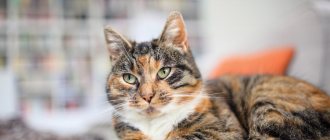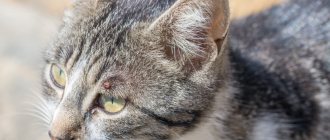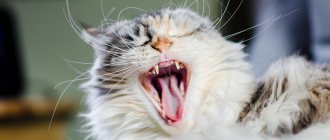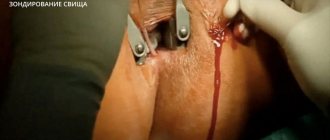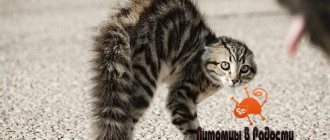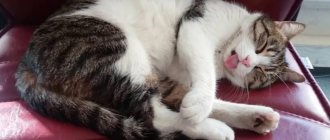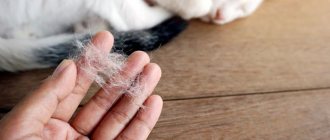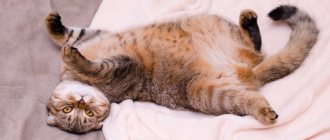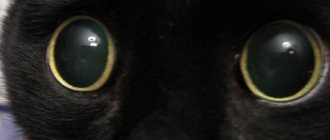Any cat owner would like their pet's coat to always look healthy and shiny. If a cat's fur falls out in clumps, the owner begins to worry. Although some hair loss due to shedding is a natural process, too much hair loss can be a symptom of a medical condition. Next, you can learn about the causes of hair loss in cats, how to treat this problem and how to distinguish it from regular shedding.
A cat's health can be determined by its fur.
Why does hair loss occur in cats?
Hair loss in cats is a fairly common problem. The reason why a cat's fur falls out in clumps and bald patches form may be a disruption in the body's functioning or the presence of diseases.
Natural causes of hair loss in clumps
Causes of hair loss in cats can be natural factors. They depend on age, time of year, quality of diet, stress level, and physiological changes.
Shedding. Seasonal molting is common to many animals. Cats are no exception. When shedding, only dead hair falls out and healthy hair grows after it. But in this case, bald spots should not form, the animal should look healthy and active.
Poor nutrition . Hair loss in cats is often caused by a lack of B vitamins. This often affects pets that are fed human food and cheap food. If a cat is given salty, fatty, spicy food, or a lot of whole milk, then the hair becomes dull and begins to fall out. This becomes especially noticeable on the neck, back and tail. The affected areas of the skin are very itchy, inflamed and flaky. Poor nutrition can cause not only hair loss, but also allergies and severe diseases of the gastrointestinal tract.
Kittens especially suffer from malnutrition. A lack of vitamins leads not only to excessive shedding, but also to rickets and the development of other pathologies.
Kittens may experience hair loss due to poor nutrition.
Stress . Cats have a very delicate nervous system. Any stress, for example, the departure of the owner, a change of environment, a long stay in the house of guests that the cat did not like, can provoke excessive hair loss, even complete baldness. The cat's health deteriorates, activity decreases, and it may refuse its usual food.
Licking is an important way to keep your cat's skin clean and healthy. However, excessive licking can lead to hair loss and other unpleasant consequences.
If a cat constantly licks the same area, eventually a bald spot will appear there and the condition of the fur in that area will deteriorate.
Excessive licking may be a sign of behavioral problems. She may lick herself to calm herself down. Boredom may also be the cause - if the environment does not stimulate play activity, the cat begins to lick itself more than necessary.
Excessive licking can lead to hair loss
Pregnancy, feeding kittens . Hormonal changes and lack of vitamins in pregnant and lactating cats are manifested by baldness around the nipples. During this period, it is especially important to maintain a balanced diet and add vitamins that will help maintain the health of both the mother cat and her kittens.
Old age . Older pets often develop bald spots in the area of the muzzle and ears, and long hairs remain in clumps. There is nothing dangerous in this, but it is worth remembering the increased risk of developing various diseases in such cats.
Skin diseases and causes of unnatural hair loss in clumps
Unnatural causes of hair loss are often accompanied by additional negative symptoms. Itching and crust formation in places where scratching, bleeding, and ulcers on the cat’s body should not be ignored by the owner.
Ringworm is one of the most common causes of hair loss in cats. This fungal infection is highly contagious and often occurs in cats or kittens kept in groups. The fungus that causes this disease is transmitted through contact with infected animals and objects. It remains viable for several months. The fungus penetrates the skin at the sites of bites, scratches and other injuries, affecting the surface layer of the skin and hair.
Ringworm symptoms manifest in different ways. Most likely, it will be noticeable that the cat has hair coming out in irregular or rounded areas. The skin in such areas may become red and peel. The coat may become brittle and look different than usual.
Ringworm in a cat
Seborrhea can be congenital or acquired as a result of internal diseases. It appears as patches of baldness covered with small scales. The cat's skin becomes inflamed, oily, and smells unpleasant. The fur comes out a lot.
Infection with external parasites . The parasites change the cat’s behavior - she suddenly begins to itch, and the unbearable itching bothers her both day and night. The pet bites off the fur in shreds, and the scratches become covered with crusts. Infections may occur. A large population of fleas also greatly affects the general condition of the cat; she loses weight, becomes restless and angry for no reason.
When flea bites, a cat suffers from severe itching day and night.
When a cat is infected with skin mites, bald spots appear on the face, ears and front legs. Areas of baldness are often located symmetrically. Severe itching leads to scratching, and the wounds often fester.
Demodectic mange is a disease caused by microscopic skin mites. This disease usually occurs in cats with weak immune systems. Redness forms on the skin, which is covered with dry scales. Then the hair falls out and itching occurs.
Alopecia is one of the types of hair loss. It can be caused by a variety of reasons, suggesting the appearance of partially or completely bald areas on the animal’s body.
Hypotrichosis is a genetic disorder that leads to complete hair loss in childhood. Newborn kittens initially have very sparse hair and become completely bald within 3-4 months. This pathology is extremely rare, does not threaten the pet’s health, but, unfortunately, cannot be treated. Most often observed in Burmese, Siamese, and Devon Rex cat breeds.
In Siamese kittens, hypotrichosis is inherited, but is extremely rare.
Hair loss due to severe illness
Constant hair loss in cats is caused by diseases accompanied by disruption of the internal organs. However, hair loss is not the worst manifestation of these diseases.
Allergic reactions are manifested by severe hair loss, skin lesions and restlessness of the cat. The causes of allergies can be different.
Most often, redness, accompanied by strong and constant scratching, occurs on the ears, in the neck, and less often on the belly and paws in the folds.
A food allergy occurs in a cat to a specific product, and it does not matter in what form it enters the body (food, canned food, natural food). Manifestation of food allergies: the cat itches and its hair falls out in clumps, and various lesions may appear on the skin.
An allergic reaction can occur when using antibiotics, household chemicals, plants, components of cat shampoos, plastic, rubber. It manifests itself as severe hair loss, profuse lacrimation, sneezing, and nasal discharge. A cat can quickly go bald.
An allergic reaction in a cat can be caused by various reasons.
Worm infestation in cats affects not only the functioning of the digestive tract. Intestinal parasites disrupt metabolic processes and suppress the immune system. The first sign of worm infection is dull fur on the cat. Hair comes out intensively due to lack of nutrients, and in severe cases, areas of baldness appear.
Alopecia areata is an autoimmune disease that causes a cat's hair to fall out in clumps. With this disease, pronounced areas of baldness begin to appear, they gradually grow, and the hair at the site of baldness is not restored. Most often noticeable on the sides, groin and thighs of the animal.
Adenitis is an inflammation of the sebaceous glands, which is caused by a genetic predisposition. It most often occurs in teenage and older kittens. Round bald spots appear on the ears, neck and head. The cat smells bad and is constantly itching. Later, baldness spreads along the back to the tail.
Adenitis in a cat
Hyperthyroidism is a disorder of the thyroid gland. Increased levels of hormones in the blood lead to seborrhea. At the same time, the cat constantly licks itself, and the hair easily falls out even when stroking the pet. This disease can be triggered by any hormonal disorder, for example, pathology of the pancreas, adrenal glands, ovaries or testes. And also the use of hormonal drugs, for example, estrus suppressants. Hormonal imbalances in cats are often accompanied by thirst and frequent urination.
Minuses
But there are also unresolved issues in statin treatment. Thus, from 40 to 75% of patients stop taking statins within 1-2 years after starting treatment. Patients name the reasons for this: fear of developing undesirable effects from the instructions for the drug (46%), disbelief that the medicine prolongs life (29.4%), taking a large number of other pills (27.6%), forgetfulness (26.5 %), poor control of blood cholesterol levels while taking medication (18.8%), drug withdrawal by a non-attending physician (13.5%). At the same time, the actual development of undesirable effects on statin therapy was observed only in 11.7% of patients, and their manifestations were mild and moderate in severity.
Muscle symptoms
The incidence of symptoms of muscle damage is 7-29%, according to various sources. These include:
- muscle pain;
- muscle weakness;
- muscle inflammation, determined based on examination of a sample of muscle tissue and/or magnetic resonance imaging (MRI);
- myonecrosis - muscle damage, determined by a significant increase in serum creatine kinase (CK) levels;
- rhabdomyolysis - destruction of muscle tissue with acute kidney damage with an increase in serum creatinine;
- autoimmune myopathy is a rare complication accompanied by severe muscle damage even after discontinuation of the drug;
The reasons for this are not well understood. According to one version, there is a decrease in coenzyme Q10 in muscle tissue and a decrease in the level of vitamin D. The work of mitochondria is affected.
Muscle symptoms occur in 7-29%.
Symptoms usually appear in both arms or legs. The period of appearance is about 4-6 weeks after starting to take statins. Sometimes, with diseases of the joints and ligaments, pain increases. This may be due to muscle weakness. Unusually, physically active people are more likely to suffer from muscle symptoms. One study found that athletes were less tolerant of lipid-lowering therapy.
According to research, these symptoms are rare. But the studies themselves often exclude older patients, those with impaired liver and kidney function, and those taking certain medications, that is, it cannot be said that this is an ordinary elderly person with a “bouquet of diseases.”
Diabetes mellitus and insulin resistance
It has been established that long-term use of statins under certain factors can contribute to the development of insulin resistance and diabetes mellitus. This is evidenced not only by research data, but also by national recommendations of some countries.
Risk factors for developing diabetes when taking lipid-lowering drugs may include:
- high body mass index (BMI);
- elderly age;
- heart failure;
- myocardial infarction in the last six months and high cardiovascular risk;
- family predisposition to type 2 diabetes;
- Asian race;
- smoking, alcohol abuse.
Effects on the liver
When taking statins to reduce the negative effect on the liver, you must avoid taking:
- alcohol;
- drugs that are metabolized in the liver along the same pathways (for example, amiodarone, sulfonamides, methyldopa, cyclosporine).
Statins can negatively affect a damaged liver.
They should not be prescribed for active viral hepatitis until liver parameters return to normal.
Drug interactions
Statins have multiple effects. This is due to the fact that they do not act in isolation, but affect many chemical reactions in the body. This is especially important in patients taking multiple medications for cardiovascular diseases.
How to understand that this is a normal shedding
If the cat is cheerful and active, and its fur is smooth and shiny, but remains in clumps on furniture and other surfaces, most likely this is normal shedding. Shedding is a completely natural period in a cat's life. In an adult animal, it lasts from several weeks to two months, but the first molt can last for a whole year.
You can tell that a cat is shedding normally by the following signs:
- wet nose;
- ears and paw pads are warm, but not hot;
- appetite is not impaired;
- the cat does not itch or chew its fur;
- Bald spots do not form on the animal's body.
Shedding is a natural process in cats
Adult cats that live outdoors usually shed twice a year, in spring and fall. Cats that do not leave the apartment all year round practically do not feel the change of seasons, so molting may become blurred for them. Increased dryness of the air, especially if the cat likes to lie on hot radiators in winter, can prolong the molting process up to three months, so you need to humidify the room.
At the age of 5-8 months, the kitten begins to change from baby fluff to adult fur, and the color may noticeably change. At this time, the baby especially needs care and healthy nutrition.
Of all the cat breeds, only completely hairless Sphynxes never shed. In other cases, molting occurs one way or another. Cats with a dense undercoat shed more often and more intensely - British, Siberian, Persian and Maine Coons. Fluffy cats, for example, Burmese, Angora, Somali, have less dense undercoat, although they grow large collars by winter. Bengal, Siamese, Abyssinian, and Singaporean breeds shed moderately - they have almost no undercoat. In the usual sense, cats of such breeds as Devon Rex, Cornish Rex and La Perm, as well as overgrown Sphynxes, do not shed. Only a few times during their lives they shed, up to the formation of bald spots, changing their fur completely. However, some of them are prone to traditional seasonal molting.
What to do if your cat's hair falls out in clumps to the point of bald patches
First of all, it is necessary to analyze the causes of hair loss: change of food, contact with an animal carrier of the infection, stress, and perhaps the time of seasonal molting.
If a cat develops itching, hair falls out in clumps, scratches its skin into wounds, refuses to eat, becomes lethargic or aggressive, it is necessary to immediately contact a veterinary clinic.
If your cat is experiencing excessive hair loss, you should contact your veterinarian.
Causes
Alopecia, in which inflammation of the skin does not occur, is formed for the following reasons:
- endocrine disorders;
- poor nutrition;
- liver diseases;
- stress.
Endocrine disorders
A characteristic symptom of hormonal alopecia is its symmetry. Hair loss occurs due to dysfunction of the following glands:
- sexual in castrated animals;
- pancreas for diabetes;
- thyroid;
- adrenal glands
Sometimes the cause of disruption of the functioning of the endocrine glands is benign or cancerous tumors. The occurrence of neoplasms is facilitated by the use of contraceptives to interrupt estrus or drugs that interrupt gestation. Treatment consists of eliminating the cause, that is, the underlying disease.
Poor nutrition
Most artificially bred cat breeds are prone to allergies to certain foods. Responsible breeders warn customers purchasing kittens what to feed their pets. The optimal solution is to use factory-made hypoallergenic food. Dry or wet food has the required level of calories, and vitamins, amino acids, and microelements are contained in sufficient quantities at optimal ratios.
The trouble with adherents of natural nutrition is their inability to plan a diet. The energy needs of cats are not taken into account. Excessive caloric intake leads to obesity. Low-calorie diets are prescribed for overweight cats. If there is not enough energy, the sulfur-containing amino acids that make up the hairs, as well as the vitamins involved in metabolism, are not properly absorbed. It is very bad if the indicated components are contained in the food offered to the cat in insufficient quantities.
Adherents of feeding natural products suspect that their pet lacks vitamins and uncontrollably uses feed additives. But an excess of biological catalysts is even worse. With hypervitaminosis, vital substances become toxins. The body tries to get rid of them as quickly as possible - with excrement and low-value body parts - hairs.
Hair is lost quickly and grows back slowly. The veterinarian prescribes medicinal food that accelerates the restoration of the coat. If the cat owner is a conscientious felinologist, he will not allow the disease to occur. The secret is simple - use premium ready-made food.
Liver diseases
The disease occurs as a result of prolonged intoxication of the animal with unhealthy food or an infectious disease. Beggar cats are at risk. Compassionate housewives treat them with delicacies, not suspecting that they are causing irreparable harm to their health.
If a kitten is not vaccinated or is not vaccinated in a timely manner, it is at risk of contracting viral infections. A recovered animal develops complications, including liver disease. In both cases, the pet is prescribed a lifelong diet. The veterinarian prescribes hepatoprotectors. The fur grows back slowly.
Stress
Cats are impressionable creatures. The appearance of a newcomer in the house, moving, a change of environment, expert exhibitions cause confusion. Sudden hair loss is considered one of the symptoms of stress. A prudent felinologist always has a calming drug in his medicine cabinet - Cat Bayun or Stop Stress. Medicines taken prophylactically prevent the occurrence of alopecia in your pet. If baldness has occurred, then medications speed up the process of hair restoration.
Why and when should you go to a veterinary clinic?
If a cat's hair is falling out profusely and in clumps, the first thing the owner should do is seek help from a veterinarian. Hair loss to bald spots can indicate a number of serious diseases.
Even an experienced owner will not always be able to independently determine that his pet is losing hair, because, for example, he has an endocrine disease. Only a veterinarian can do this after reviewing the cat’s hormone tests.
To establish a diagnosis, the cat needs to be examined by a doctor and undergo tests. From the place where the fur grows in clumps, they take a piece of skin for analysis and study the condition of the fur. These tests will show the overall picture of the disease and help develop treatment. Depending on the diagnosis, surgical or drug therapy is prescribed. The pet owner will only need to follow all the veterinarian's instructions.
Possible options
Every cat licks under its tail at least several times a week. This process should not be considered pathological, provided that the animal is regularly treated against fleas and ticks (at least once a month) and undergoes quarterly deworming.
If you add accompanying symptoms such as redness in the anus, discharge or the appearance of growths, it is recommended to exclude the following diseases:
Inflammation of the paraanal glands
It can form after eating bones, due to excess weight, soft food. Prolonged diarrhea can also be a cause.
The first signs of inflammation may include fidgeting on the butt, constant licking under the tail, and redness in the anus. The problem can be solved by cleaning (at least once every three months, if there is a predisposition to inflammation).
It is performed by a veterinarian in a hospital setting. After cleaning, ointments (proctosedyl) and suppositories (ichthyol or sea buckthorn) are prescribed. A change of food and increased hygiene are also indicated.
Fleas
They can cause itching in different parts of the body. But most often bites occur on the base of the tail and stomach. Therefore, if a cat licks under its tail, behaves restlessly, tries to chew out fur, or tears itself with its paw until it bleeds, then flea treatment should be carried out. The fact that your pet does not leave the house is not 100% protection against parasites.
The owner himself can bring them on clothes or the soles of shoes. Fleas are not dangerous to humans (they do not parasitize the skin), but in some cases they can bite. All animals are treated, regardless of the presence of symptoms.
The most effective drugs are Stronghold and Frontline. They are produced in the form of drops, which are evenly applied to the withers so that the animal cannot lick the drug. It is recommended to perform this procedure at least once a month.
Worms
The most common reason why a cat may lick under its tail frequently. Just like with fleas, an animal does not have to go outside to pick up parasites. He may develop them after being bitten by mosquitoes, mosquitoes, or fleas.
Also at risk are pets whose diet contains raw meat and fish. Well, we cannot exclude the possibility that parasite eggs may enter the apartment on the soles of the shoes of the owner or his guests.
The first signs of worms are itching in the anus, due to which the cat can ride on its butt on the floor. Licking and gnawing of fur in this area also indicate discomfort caused by parasites. Diarrhea, vomiting and increased appetite (or, conversely, complete refusal to eat) can be considered concomitant symptoms of helminthic infestation.
Veterinarians recommend starting to worm animals from 3-4 weeks of age. As preparations, you can use tablets, suspensions or drops on the withers. Of the tablets, Drontal and Milbemax are considered the most effective. They can even be given in crushed form, adding to food. Some manufacturers offer meat-flavored tablets, since many pets flatly refuse to undergo deworming.
Injury
This option cannot be ruled out. A pet can injure the anal area while climbing trees or after playing or fighting with other animals. Even a small scratch can cause significant discomfort. Because of this, a cat can constantly lick under its tail until it becomes bald.
In such cases, it is recommended to carry out antiseptic treatment of the affected area until complete healing. And limit the animal's access to the wound using a special medical cap.
Neoplasm
Unfortunately, this option should also be considered, especially if the animal is over 10 years old, it has been treated for parasites and there are no visible injuries in the anal area. The tumor can irritate the intestines, which explains the pet's restless behavior. The cat constantly licks under its tail, refuses to eat, and suffers from constipation.
If necessary, the doctor performs diagnostic laparoscopy, during which cells are taken from the formation for histological examination. Depending on the type (sarcoma, lymphoma) of the tumor, treatment is selected (chemotherapy, surgical excision).
Unfortunately, with tumors in the intestine, the prognosis is always cautious, even if the operation is successful and there are no metastases.
Finally, I would like to remind you that if a cat licks under its tail after giving birth, this may be an alarming signal for the development of pyometra, which can “burn” the animal in a few days. Therefore, in the postoperative period this symptom should not be ignored under any circumstances.
Watch this video on YouTube
Treatment of hair loss in cats
Hair loss in cats can be eliminated with the help of comprehensive measures - drug treatment, adjustments to living conditions and diet. To determine the cause of your cat's hair loss, you need to consult a veterinarian. He will prescribe the appropriate treatment.
Hair loss treatment is carried out comprehensively
Medicines
The first step to a beautiful and fluffy coat is removing parasites. First, an insecticidal treatment is carried out to destroy lice, fleas, and ticks. For this purpose, drops are purchased at the veterinary pharmacy. They should be used strictly according to the instructions, without exceeding the dosage. If there are a large number of fleas, the treatment is repeated after 7-10 days.
Dichlorvos and other chemicals not intended for cats are strictly prohibited. The use of medicinal products for humans is also prohibited. Even safe paracetamol can cause serious complications in a cat.
3-7 days after the procedure for treating external parasites, a drug is given to remove helminths. The tablet should be given in the morning, with food. The dose is calculated according to the cat's weight.
Sedatives are used to reduce stress levels. Antibacterial and antifungal drugs are used to combat bacterial and fungal infections. For the proper functioning of immune cells - immunostimulants.
All medications, dosage and course of therapy are determined by a veterinarian depending on the cause that caused hair loss.
Give your pet only the medications intended for it.
The use of medicated shampoos and special preparations
In addition to taking medications, antiseborrheic shampoos, ointments and antiseptics are prescribed to treat suppurations.
Medicated shampoos are mainly designed to combat parasites. They contain not only a substance that can get rid of parasites, but also relieve itching and irritation in the cat. Flea shampoo for pets will also help heal small wounds and scratches on his body. Special flea shampoos have been created for kittens, consisting of herbal extracts, vitamins and essential oils.
Anti-dandruff shampoos for cats are designed for animals with problem skin. Its composition, like the anti-lichen shampoo, includes antifungal drugs and special components that will eliminate dandruff, flaking and crusts that appear due to seborrhea.
Anti-allergenic shampoo is intended for cats suffering from frequent manifestations of allergies on the skin. This shampoo contains no allergy-causing ingredients and also prevents irritation from dandruff or any external irritants.
Diet for hair loss
For effective hair growth and healthy skin, your cat needs a large amount of protein. About 30% of daily protein intake is used by the animal's body to renew and form skin cells. Not getting enough high-quality protein in your diet or consuming protein that is poorly absorbed can lead to brittle, thinning hair and hair loss.
With a natural diet, the basis of the diet for 4-5 months will be: lean meat (pork is excluded), lean sea fish, semi-cooked without bones, lungs, heart, liver, stomach and other offal, kefir, low-fat sour cream, small quantities of vegetables, steamed cereals boiling water or broth.
When feeding commercial dry and wet food, it is necessary to choose a high-quality product intended for allergy sufferers.
Vitamins A and E are also very important for maintaining a healthy cat's coat and preventing excess shedding. They regulate cell growth and act as natural antioxidants. A lack of these vitamins can lead to disruption of the production of keratin, which is the main component of hair. B vitamins and biotin will help restore fur faster.
For a beautiful coat you need vitamins and a balanced diet.
Diseases of internal organs
A disorder in the functioning of internal organs also leads to the appearance of bald spots in furry pets. Veterinarians name the following diseases that lead to a pet going bald:
- Pancreatitis. The disease is accompanied by bowel dysfunction. A sick cat often suffers from diarrhea or constipation.
- Cirrhosis of the liver. One of the reasons for the development of the disease is a chronic lack of B vitamins. The pathology occurs due to the replacement of liver cells with connective tissue. As a result of this, the organ is gradually destroyed, and this affects the condition of the entire animal’s body.
- Digestive system disorder. Gastritis, colitis and other pathologies of the gastrointestinal tract lead to alopecia in cats. If your cat suddenly becomes shabby and loses its appetite, it needs to be shown to a veterinarian.
Preventive measures
The quality of the coat is an indicator of the health of the cat. If an animal is losing a lot of hair, it is important to notice it promptly and take action. The main measures that the owner can take to keep the cat beautiful and fluffy:
- Selection of a balanced diet. Natural food should contain all the necessary vitamins. Dry and wet food must be of high quality, specially developed in accordance with age, condition (pregnancy, castration, sterilization), concomitant disease - medicinal lines of food.
- Antihelminthic courses. Veterinarians recommend every 3 months.
- Use anti-flea collars or regular treatment with special drops.
- Mandatory vaccination.
- Elimination of foods and items that cause allergies.
- Proper care – regular brushing and grooming.
- Maintaining cleanliness in the room.
Caring for and caring for your cat will keep it healthy for a long time.
For timely detection of hidden pathologies, veterinarians recommend taking tests every year. Elderly and weakened cats with chronic diseases need to visit a veterinary clinic twice a year.
Caring for your pet will help you avoid serious illnesses. Only if you follow all the recommendations, the cat will have a beautiful, thick coat and a healthy appearance.
Prevention
Problems when a cat has bald ears, belly, peeling heels, back or tail at the base arise quite often, but they are quickly treated. But in order not to injure the animal, violations should be prevented. To prevent the appearance of alopecia, veterinarians recommend monitoring the hygiene and nutrition of the animal. The cat must be kept in clean conditions so that it does not get infected. In order to identify violations in time, it is advised to regularly consult a doctor and independently check the condition of your pet’s skin. This will allow you to find out at the first stages of the development of the pathology why the fur is coming out and remove the disease. If hair falls out on the ears or the back becomes bald, you cannot treat it yourself, so as not to worsen the condition of your pet.
